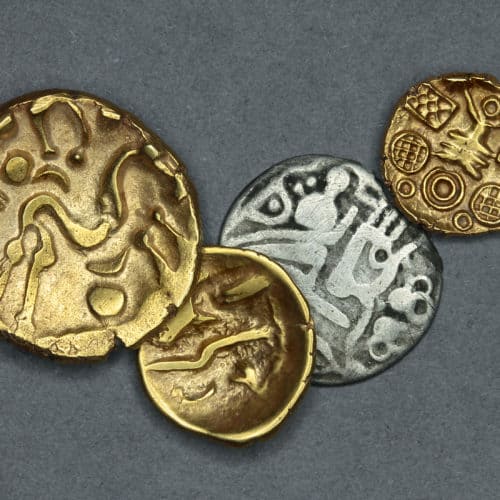Stone Age to Iron Age activity 7: make an Iron Age gold stater
Investigate Iron Age coins, including potins and gold staters found on the East Cliff site at Folkestone, some with swirly Celtic patterns and strange horse designs.
Then make your own Iron Age gold stater inspired by what you’ve seen.
Image copyright: Canterbury Archaeological Trust
Learning objectives
Increased knowledge and understanding of Iron Age coins and commerce.
Curriculum links
KS1-2 History (Iron Age, Local Area Study).
KS1-2 Art and Design (Make an Iron Age coin)
A detailed but good background introduction to Celtic coins in Britain (for teacher reference).
http://coinproject.com/jan/volume1/issue4/volume1-4-2.html
Start with Learn with Objects Stone Age to Iron Age 2: metal shapes. Ask the children to look at the photo showing the gold and silver coins uncovered by archaeologists on Folkestone’s East Cliff. Ask the the following questions:
- What designs and patterns can you see?
(a horse, a stylised person, strange circles). - What materials are they made out of?
(gold and silver) - What do you think they were used for?
(these are Iron Age coins, the coin on the left, with the horse design is called a gold stater). - What did people do before there were any coins?
(barter)
- Why were coins invented?
(to make buying and selling things much easier)
Some background information on Celtic coins
Celtic coins starting coming into Britain in about 150 B.C.
These were mainly gold staters and quarter staters minted in Gallia Belgica (northern France). These were copied from copies of gold staters of Philip II of Macedon.
Most of the imported coins were probably the result of cross-Channel trade.
The Greek geographer Strabo (circa 60 BC to AD 20) lists the main exports of Britain as ‘grain, cattle, gold, silver and iron … also hides, slaves and dogs that are by nature suited to the purposes of the chase.’
Around 80-60 BC, a Kentish tribe, probably the Cantii, produced the first coins made in Britain. These were cast in ‘potin’ - a tin-rich bronze alloy. Known as Thurrock potins, they are named after a hoard of about 2,000 coins found in a pit at West Thurrock, Essex, in 1987.
The first gold coins made in Britain (circa 70-60 BC) also come from Kent and are known as Kentish A staters. These may have been issued by the Cantii to pay British soldiers to fight a tribe called the Suessiones from Gaul.
Make an Iron Age gold stater
Search gold stater or Kentish stater on Google images to bring up lots of pictures of this kind of coin. Pupils create their own stater design inspired by what they see.
Work big for greater impact. Designs can be drawn in pencil on cardboard picnic plates, which can then be painted gold.
Make sure you remind the children to paint in the darker shadows and lighter highlights to give a stunning 3D effect.

